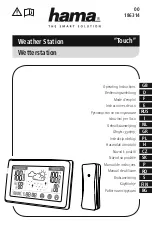
Version 1.1
©Copyright 2011, Ambient LLC. All Rights Reserved.
Page 4
The weather forecast or pressure tendency is based on the rate of change of barometric pressure. In
general, when the pressure increases, the weather improves (sunny to partly cloudy) and when the
pressure decreases, the weather degrades (cloudy to rain).
The weather forecast is an estimation or generalization of weather changes in the next 24 to 48 hours,
and varies from location to location. The tendency is simply a tool for projecting weather conditions
and is never to be relied upon as an accurate method to predict the weather.
The barometer includes a manually set needle, which is used to mark the current measurement so a
change can be seen. Barometric readings should be taken daily. Remember that the rate of change of
barometric pressure is important in determining weather changes. You may want to take multiple
readings each day during periods of unstable weather conditions.
The following basic rule of thumb will hold true in using the barometer to predict weather conditions.
A fast rise in barometric pressure means goo weather of short duration.
A rapid drop in barometric pressure means disturbances nearby, showers of short duration.
Regular elevation in barometric pressure usually will indicate a clear, dry weather conditions
(cold and dry in the winter).
A slow but continuous drop in barometric pressure will indicate persistent, bad weather.
Slow drops of 2-3 tenths mbar per 24 hours a depression of some distance away.
Drops of 1-2 tenths mbar per hour means disturbances nearby of short duration.
Steep drops of 6-10 tenths mbar within 4-5 hours period indicates coming rain and/or storm
with strong winds.
5.3 Absolute vs. Relative Pressure
To compare pressure conditions from one location to another, meteorologists correct pressure to
sea-level conditions. Because the air pressure decreases as you rise in altitude, the sea-level corrected
pressure (the pressure your location would be at if located at sea-level) is generally higher than your
measured pressure.
Thus, your absolute pressure (measured at your location) may read 28.62 inHg (969 mb) at an altitude
of 1000 feet (305 m), but the relative pressure (sea-level) is 30.00 inHg (1016 mb).
The standard sea-level pressure is 29.92 in Hg (1013 mb). This is the average sea-level pressure
around the world. Relative pressure measurements greater than 29.92 inHg (1013 mb) are
considered high pressure and relative pressure measurements less than 29.92 inHg are considered low
pressure.
To determine the relative pressure for your location, locate an official reporting station near you (the
internet is the best source for real time barometer conditions, such as Weather.com or
Wunderground.com), and set your weather station to match the official reporting station.
5.4
Barometer Calibration
Your barometer will operate from -100 to 3,000 feet with reliable accuracy. Aneroid barometers have a
small screw on the back for sea-level calibration. With a flat blade screwdriver, turn this screw in
either direction slightly while looking at the indicator needle. It should move in one direction or the
other. Tap the barometer to see where the needle settles. Continue this procedure until the proper
pressure reading is obtained. Do not turn the screw counter-clockwise (to the left) too far, since the
screw can fall out. After the initial calibration, no further adjustment will be required unless the
barometer is moved to a new geographic location.























